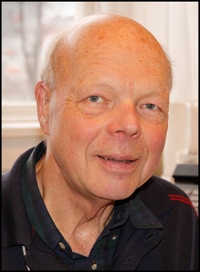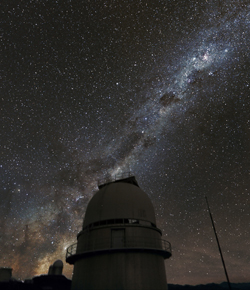50 busy years with stars, telescopes and international collaboration
Johannes Andersen is an associate professor of astronomy at the Niels Bohr Institute. He started studying mathematics and physics at the University of Copenhagen in 1963 and after a year he was hired as an instructor of mathematics – the same course that he was following himself. In ’69 he received his Master’s in astronomy and was awarded a gold medal for his thesis. This led to a three year research grant and it meant he could study anywhere in the world he wanted to.

Johannes Andersen is an associate professor of astronomy at the Niels Bohr Institute. He has had 50 busy years with stars, telescopes and international collaboration
After a year in Denmark, he went to Marseille in France and here he met the Swedish astronomer, Birgitta Nordström, who he later married. They spent a year together in Victoria, B.C. in Canada. In ’72 he returned home and became an assistant professor and then an associate professor at the Astronomical Observatory Brorfelde. The family also lived in Brorfelde and two of the couple’s three children were born there before the family moved to Holbæk.
Development of instruments
In 1967, Denmark became a member of the European organisation ESO and part of Johannes Andersen’s job description was to take on assignments with international collaboration. The project with the Danish 1½ meter telescope at La Silla in Chile was in limbo due to poor project management, so Johannes Andersen spent 2½ years getting the lens repaired and developing instruments so that the telescope was a tool for Danish astronomy for the next 25 years, as was the intention.
He also helped to develop a programme of spectrographs for the ESO 3.6 meter telescope at La Silla.
During 1986-89, he was in the United States at the Harvard-Smithsonian Institute in Cambridge, where he was involved with the initial development of CCD detectors for astronomical use.
“The advantage of the CCD detectors was that they are much more sensitive than photographic plates and data can go directly into the computer. So when I came home from the United States I applied for a SNF grant to develop CCD cameras for the Nordic Optical Telescope, NOT, on La Palma in Spain in ’94-’95 and on the Danish telescope in Chile,” explains Johannes Andersen, who is still in the process of developing a new generation of detective systems for Danish astronomy.
Stars of the Milky Way

From a research perspective, Johannes Andersen has focused on the stars of the Milky Way and their evolution. He has studied how a galaxy like the Milky Way is created and what happened at the very beginning of the Milky Way’s history. The picture shows the Milky way seen from La Silla in Chile.
From a purely research perspective, he has focused on the stars of the Milky Way and their evolution. He has studied how a galaxy like the Milky Way is created and has made models of stellar evolution. The Sun was first ‘born’ when the Milky Way was 9 billion years old and he has studied what happened at the start of the Sun’s neighbourhood in the Milky Way. But for the last 10-15 years, his research has mainly focused on what happened at the very beginning of the Milky Way’s history.
Organisational work
Johannes Andersen was the head of the institute at the Astronomical Observatory under the University of Copenhagen from’82-’84 and again in 92. While at Harvard-Smithsonian in the United States, he had to rush home in ’88 to write a report that, together with a large grant from the Carlsberg Foundation, helped save Denmark’s membership of ESO and the VLT (Very Large Telescopes in Chile). The report became a ‘roadmap’ for Danish astronomy and after returning in ’89, he was responsible for putting the recommendations into practice in several instances, not the least when the Astronomical Observatory would become part of the new Niels Bohr Institute in ’93.
From ’97 to 2000 he was the Secretary General of the International Astronomical Union and from 2002 until 2013 he was the director of NOT, while still an associate professor at NBI. 50 years in three ‘halves’
“My work has been half instrument development and half research with the instruments – and then an additional half a lifetime of international collaboration,” sums up Johannes Andersen his 50 busy years in the astronomy world. A reception will be held for Johannes Andersen September 4th at Rockefeller.
